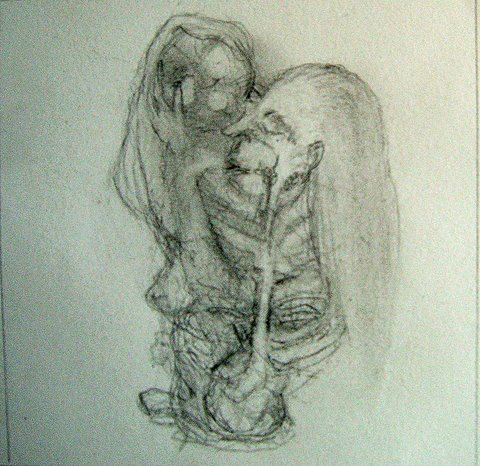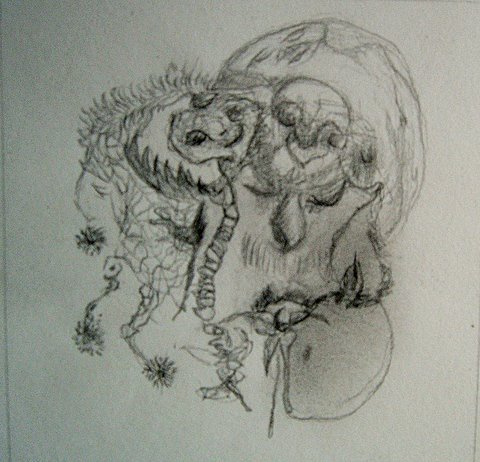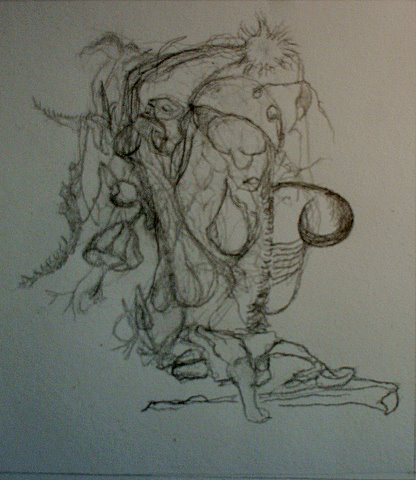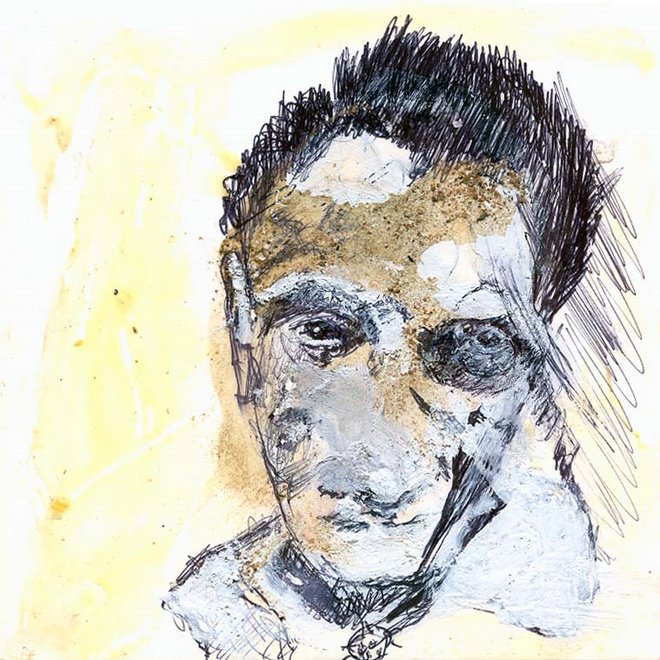Call for New Animism: Received, Listening for the Reply
please be aware that these are only my notes for the talk, not what I actually delivered
please be aware that these are only my notes for the talk, not what I actually delivered
 | |
| Atmospheric Distubances inside Hranicar Gallery Space, Usti Nad Labem |
Call for New Animism: Received, Listening for the Reply
my working title for an inquiry into how constructed spaces
for listening may or may not be functioning to bring about sensitivity to the
actual winds of the real weathers, nueronal or cosmic, global problems and the limits (of controlling)
interspecies communications.
--- or ---
Where Does the Listening Really Begin?
* the working title for the sound performance I presented at the Murmurans Mundus conference
-- but which title was changed to...
Where the Wind Begins, after the actual performance
 |
| this is the drawing for my tech rider for my 4 channel dissemination sent to the phonon crew |
Part 1
Some if you may
know the scene from the extraordinary film of Satjit Ray called Pater Panchali
where the children hear the sound of the locomotive train & then run to
watch as the machine advances down the track belching huge black coal smoke
into the sky.
They greet it as the arrival of an exciting new otherness.
They wave at the wave of the industrial colonial future that probably does not
see them. That its an image of death only seems confirmed much later. But the
sound is the harbinger. The film goes on with the music of Ravi Shankar and the
images celebrate the beauty wonder of small creatures flitting across ponds and
living small lives. The music of the subcontinental Indian culture seems to
celebrate and enshrine the lives of small creatures whose weave and shuffle are
bound into the biogenetic material that, for those of us who still feel
evolutionary heredity in their bones, we can think of as the lives of
ourselves, our voices. In the culture of the subcontinent we also find the most
ancient respect for the concept of sound as a generative, propulsive and
positive force of elan vital. What breathes well lives well. Breath in and out
with an O-shaped mouth, you'll feel better. It's this somewhat, or entirely
childish way of greeting even the terrific deathly machines with glee which I
call animism – the most ancient philosophy among humans perhaps. One thing for
sure is that if I wanted a propaganda for animism it would be this one and
backing it up is the great Hindu religious and philosophical tradition firmly
rooted in waves of sound.
Yesterday Tomas Senkyrik's
lecture and performance also demonstrated a dynamic relation to personal atmospheres that in the American ecopoetics is called
“the local” – and the local celebrates and focuses on the lives and sounds of
smaller life-spanned creatures whose small and yet crazy passions for life
create marvelous resonance regions. Resonance regions is a phrase that I
adapted from the environmentalist Peter Warshal
– who was concerned
with Luminosity Locales. His studies revolved around the unique ability of biological entities, accidental
or not, to store packets of photonic energy for later heat-conductive processes.
“The Sun is the initiator of all sugars."
Energy storage for later use is seemingly the essence of the biological
paradigm. It takes many locations and many regions to result in this resonance
that we call the world, the planet earth, the galaxy, the cosmos. How we store
data in the hive-mind may be similar to how primordial life-forms configured
their nucleic acid lattices in limestone imprints patterns which are the
shock-waves of ancient volcanoes or ridges of sands when sea-water recedes.
Tomas' presentation
of the local resonance is something quite in contrast to Peter Cusacks'
presentation of the dessicated Aral Sea Basin and the idea of recording
dangerous places.
In the world of Tomas's Moravia we meet his ears in his yard, at some
wetlands 5 or 10 km away, in his basement with fermenting plums, in the
dovecote of his grand father. All of these places speak to us of the local and
the familiar, the familial, where agency is clear, detectable and in a sense
reassuring of life-cycles and continuity with nature.
Peter's work within the
dangerous places, disaster aftermaths, depleted zones, on the other hand confronts us with either an undetected agency
or one that is alien and unfamiliar, representing an absence of familiarity,
often in the form of the locale of a disaster or a place that is no longer a
place, like the coal mines in Germany, holes in the space and time and earth. So, I underline with this two senses of location and
distance woven together by technologies. And semantics.
 |
| Usti Nad Labem, View from Student Residency Hall, 11th Floor. |
Part 2
"Our world is
textile."
-- Jérôme Jolibois (Brussels-based Nudian
Activist)
Throughout my talk
you will hear me use the metaphor of weaving quite often. It seems inescapable
since I've long ago married the cilia of the inner ear with this ticklish
interface of neural to and fro whose consciousness is sound. Penelope, wife of
Odysseus, is perhaps the most famous weaver, spider-lady, of the West, for she
also unweaves by night what she weaves by day -- tricking time and minds --
(the funeral shroud for her missing, thought-dead husband). William Blake also
wrote that Space and Time were woven in Enitharmon's loom. Jerome Jolibois'
idea about textile fascinates me. He identifies textiles with civilization and
clothing, the wearing of which hinders his feeling of being in contact with the
winds. The winds are also in my writing here not merely as gusts of air but as
carriers of ideas and emotions. We both shelter ourselves from winds but need
the winds to push the wheel of the seasons and the signs of those seasons sound
clearly in the winds
Very few people can say winds are "insignificant"
(unless they've never felt them). The idea that the global environment speaks
to us with the phrases of wind is the root of my idea that we should listen to
the voices of the planet that are telling us things we might do well to learn.
My pleasure therefore is a call for new animism. Listening closely may be the
key to the revival, of resonance research and cloud mapping...
"The noise of the world
is just wind
changing names
changing sides"
These words are
taken from Yannick Dauby's recent installation called the Noise of the World,
in which he draws a series of portrait-frames around sounds captured at Green
Island -- each episode opening and closing with an ominous clanking of prison
door. The island was once a penal colony and he explores in some instances the
borderless-ness of sound which might have reachrd the incarcerated from the
outside world. The prison of listening was an unlucky, unhappy phrase that came
to mind, as I imagined all the other senses being limited, most active freedom
restricted, no wind to blast, nor to caress, the skin. Often when I sit in my
own home or studio positioned optimally at center between my stereo monitors I
wonder about what I have been doing with my time, this way, putting myself at
center, constructing the middle. But I am more or less free. I am a bit like
Penelope though, weaving and unweaving recorded time frames. I am not waiting
for Odysseus but maybe trying to deceive the Master Death waiting in the wings
 |
| beautifully colored & likely toxic sludge by-product of the chemical factory fires in Rouen |
Part 3
There is one little fellow named Ecology,
and in time we shall pay him more attention.
--Kenneth Burke,
1937
(thanks to Minneapolis drummer & afferent musicologist, Davu Seru for the citation)
My acoustic ecology underwent a sea-change when I discovered, or noticed rather, that I spend a tremendous amount of time trying to micro-manage or construct my sonic environment, creating orchestrations of my surroundings. I re-lived a 2 month back-packing and camping journey through Romania and Ukraine (listen here) for the next 5 months suing my spare time in Poland piecing together my phonographies into aural idylls. Whether through composing music, walking in the forest, making podcasts, interviewing people, creating soundscapes (sound-escapes) or removing myself from noisy environments, sleeping, traveling as often as possible -- much of this effort derives from the direct experience of the overloaded sensory environments, of stasis and a premonition or intuition, that the production of sound (on my behalf) needs to balance with the environment. This of course stands as a measure of the imbalance I perceive myself standing within, spending most of my year in Poznan, a city of commerce, coal burners and too many automobiles.
Looming evidence of radical climate changes only seemed to make me more reclusive
and I perceived myself drifting not in the direction of the lobbying sort of activism, because I am aware of the ideologies and unquestioned metaphysics of science, there are too many tricks and trolls in the climate debate politics -- so I choose too and more in touch with my musical and poetic predecessors, the shamans. This is turn leads not towards politics and politicians but to listening to the people who I travel among while listening to their acoustic resonance region.
Being a person raised in the city (Buffalo, NY) and living in some major conurbations, these desires to escape noise and shift this balance away from industrialism long ago attracted me to the entire arc of quiet music movements, Cage (we always have to say "what side of the Cage are you on" in this respect), Javanese gamelan, raga, Japanese traditional, onkyo, reductionism, lower case, drone, sculpting with phonographies, R.Murray Schafer -- all of this had something to do with corrective sonic surgeries on some pulsating noisy advertisement over-load of urban, industrial extremism. But these surgeries seem to be largely cosmetic. It seems difficult to imagine reversing the mechanical noise levels linked to the market which binds production to the military industrial complex. The noise will only increase as time goes on even if we increase operations to reduce that increase since creating our "escapes" also generates more carbon imprints.
Weaving and un-weaving. Or, as the poet Robert Duncan once
wrote, in a brilliantly commemorated Freudian slip, "re-weaving and
we-reaving". What we cannot
untangle or un-weave, we sometimes tear apart.
Since most people
do generally feel overloaded with all the data but the data suppliers keep
multiplying and the consumer base keeps growing, What is going on?
What's the
psychological message of all the noise and over-production? And why do we need
to escape it or change it? And how have we been able to do that? How have we
tried to use our ability to make sounds counter-act the information overload of
the processed world? Have our phonographies or music processes led us back into
a more profound connection with the natural world just make more hash from
hashtags?
Perhaps we can
thank our own organisms for the implicit, instinctive answer, an organic
rebellion against overdosing the data transfers. At root, in the center of the
brain, there is the pineal gland and it's cycles of neuro-transmitter chemical
productions linked to circadian rhythms. Without drugs, eventually, you must
sleep and find the music of your own internal organic life. What? Is there sun
of sounds and we require a darkness of sounds, some zero resonance zone, where
all sounds heard simultaneously peak in a blackout silence we call slumber?
Perhaps the
over-production is related to horor vacuii -- the spiritual void of the
post-god-is-dead world -- a need to ensure that our net of presence-ing
ourselves goes unbroken? I assume that the fears are very real and that the
painfully slow dawning of the impact of climate change indicates that we feel
we can artificially save ourselves, with technology and cultural representations,
permitting the simulacral fantasy of control to reign supreme, as long as we
are reflected in the eyes of our friends. While what we need to do -- the
planet seems to be demonstrating -- is that we need actually to do less and to
want less. Listening in this context need not reflect so much as absorb, or
transmit internally whatever sense of belonging we might have. There seems to
be a limit in the collapsing of the expansion of knowledge that brings us back
into our own bodies.
In these circumstances
it seems that to make any great contribution in a certain sense one ought to
refrain from making any contribution. It's a question of scale. Why make books,
vinyl records, cds, when one can use the internet to share loss-less files?
Nostalgia has a hold on people and ritual consumption seems bound with
civilization and it's need to appear better than what it fears and seeks to
define itself against: savagery,
nature, chaos, entropy. We listen to things which reinforce the ideology that
once made us feel good. We binge-listen to old faves. This guitar kills
fascists, so let's buy another one.
Our sounds seem
to be so entangled with our own ordering principles and mesh so thoroughly with
the science of the natural world that I have wondered if we are at the origin
of this process or that it's the opposite, that we follow unconscious orders blindly, that we
forget we are half-artifice or some proportion of artifice mixed with the
physical reactive universe. The artifices of the hiding agencies are often cultural. We need to
untangle our perceptions. But each artifact of perception generates further
physical facts. Like the cilia in the cochlea there is a tingling back and
forth tuning which is built on a set of firing parameters, they regulate toward
stability, calm, agreement. if they don't achieve that effect the stimulus
circuit ping-pongs who knows for how long...
It seems
however, if some of you follow recent research into enzymes, neurology and
quantum mechanics, this physical & active universe seems to sit on top of
something that is static, or entropic or seemingly without any reactive
tendencies at all, not even dead because it's maybe never been alive or a
substrate with such extremely slow reactive tendencies, that it's appearance is
inert and dark, unconscious. Another matter. Dark matter. Perhaps it draws
everything by the 3rd law of thermodynamics down into it's own collapse into
some absolute immeasurable inertia.
Through a kind of
inner body dynamic sound unravels pranic geometry, a tantric, which moves or
life pulse and dna in both directions simultaneosly by the laws of gravitational
dynamics and geometry of sound centers corresponding to outer circumstances
dependent on these --- resonance is the tonal balance between inner
and outer winds --
In the Hindu
tradition we find five types of prana, collectively known as the five vāyus
( vayus are "winds" -- and some of us who follow any Eastern
disciplines recognize similarities to the energy paths through the body and
that uniting it all with Western anatomical research we have already a kind of
picture of the body and it's pranic, vayic or qi cycles. Perhaps now we who are
doing this work in acoustic ecology are ready to bring the inner and the outer
forms of listening into one endless spiral. The ear and it's structure can
functions as a point if departure for this and I'll get to that in a
moment
Part 4 (I never had a chance to even imagine getting this far into the presentation...)
Our sounds are woven objectively within the order of the
cosmos and that part which is called music is what falls within the realms of
the categorization and ordering of our sounding relationships, the ones that
makes sense. We create this order as shield against what we don't know. This
tendency to shield against the unknown began to break down in the late 20th
century. Music opened itself to wider influences, both culturally (world
musics, new tone systems, timbres) and by re-considering the role of pure sound
in the process, largely due to the ability to abstract sounds from environment
offered by recording technologies, music expanded to also include the
possibility of pure listening, and listening started to be, or to return to the
old order of animistic listening, the primary organ of musical composition.
Thusly, the ear was born again into refreshed circumstances.
This may seem obvious, but some parts of that cosmos are not communicable and even insensate and without possible purpose in any system of meaning known to any previous aesthetic paradigm. They are untuneable, uncontrollable, unpredictable. For this reason they remained frightening for most people. But this fear also started to breakdown when the incommunicable didn't respond and seemed to work on different terms. It was then we started to get another confirmation that listening or paying closer attention to everything was the only way to understand what was going on "out there" and that any sense of harmony with that was only perhaps to be gained by ceasing to try to control it. This is all reflected in the course of that famous century before the last one, since 12 tone theory and serialism began the integration process with the elemental and molecular cosmos and the aleatoric music of Xenakis started to influence younger people doing electronic and noise musics.
Xenakis is important as a step into the
territory of where creative dynamics and probability patterns in physical
dynamics weave with one another and brings some of my own weavings and
unweavings to a new opening
Mixing things up was suddenly a more efficient way for the human
ordering system to evolve. That's perhaps why now in the 21st century people
are thinking about how we and our passing gasses are forcing the rate of our
climate changes and not really just a bit anymore. They can feel it happening.
It's been happening in our music since serialism and free jazz and musique
concrete. My feeling is that it's a good sign that somehow we can already feel
this reaction finally. And perhaps listening to that is a legit preoccupation.
But this is all based upon the relation between the wind, the storm, the chaos,
being perceived as significant. And most every does the feel the wind has great
significance. Once upon a time people even thought the wind was animate.
Part 5
In the writings of Boethius, the analyses of music is tripartite. Music of the heavenly spheres, "loud and continuous, beyond human range" according to David Hendy anyway is said to be seen by Boethius is the heavenly bodies and in the elemental changes of the seasons -- so here we have the geological, global grounding. the music of the spheres is not the arcane mathematical issue of the pythagorean mentis
In the writings of Boethius, the analyses of music is tripartite. Music of the heavenly spheres, "loud and continuous, beyond human range" according to David Hendy anyway is said to be seen by Boethius is the heavenly bodies and in the elemental changes of the seasons -- so here we have the geological, global grounding. the music of the spheres is not the arcane mathematical issue of the pythagorean mentis
but in fact something
physical, celestial, mechanical but moving at such a speed that it seems
silent.
instrumental music is of course is self-explanatory.
But the
"human music" within the human organism, the body itself, is
something Boethius doesn't say much about except that one can feel it if one
wants. Intra-corporal music is proprioceptive. But we have great traditions in
the chakra theories of India and the QI flow systems of Chinese medicine, all
of which suggest that is the human body is to be used as a model for music then
both complexity and clarity must be resolved.
While Boethius, struggling with the classical world and
trying to find resolution with new faith systems between the East and the West,
he seems a bit deaf and insists we can't hear the higher vibrations of
celestial music and he seems shy about the inner workings of the human
organism. This is probably just the by-product of the rational mind obscuring
things for political reasons. Anybody who listens can hear the workings of
their own bodies. So what was going on with the haptic perceptual fields? Two
things: the ideology of the unknowable workings of the mind of the
Judaeo-Christian god closed the doors of that perception. And the beginning of
the dark age of the human body began and everything associated with it became
base and material, opposed to the soul itself. Our ideological disembodiment
which seems know rather at it's last phase.
But I'd still like
to use this same three part division and jump to an analogy with the structure
of the inner ear, the human ear anyway, where we have something similar:
because the outside is always continuous, a kind of overwhelming racket --
while the tuning in and out of this is achieved by the instrument itself, the
ear, which I would suggest, is the archetype for all instruments, and it's
composed as most of you know by a
tympanum membrane which stimulates the malleus, incus. stapes -- but
what some of you may know also but which is the trickier part is that the cilia
which vibrate set the scale because they have a bit of separation among them.
And, as I understand this, it's two-way street between the cochlear nerves and
the vestibular which meet in this meshing of cilia and kind of maintain and
ongoing neural debate which creates the sound or the sense of the sound. One
set is sending the vibration into another set which vibrates in a feedback loop
against what messages it's being sent -- this is what synapses do also, firing
back and forth to create this gapped sensation of continuity --
within this inner ear zone is the -- tipping point between
inner human music and outer "human music" which is a hermeneutic
zone, one of interpretation and searching, comparing inner data stores, sending
them to met the incoming perceptions, as if asking, are you what I think you
are? in the case of a musician this relay system is what allows for the
adjustment we call tuning...
by the way, it's been suggested that tinnitus is the result
of the a enzyme deficiency/imbalance causing a misfiring on the brain-side of
this system, the result being that your brain sends a stimulus back to the ear
but it gets kind of trapped there,
stimulates the apparatus without any incoming air pressure and causes
you to feel a bit crazy...
Part 6
comments on so-called ambient music, the asemantic corridor back to listening to earth voices
Ambient music as
carrier signal for consciousness as in freeing the mind from semantic listening
at one level and allowing heightened attention at others. It can perhaps be
thought of as a transportation device to a higher silence.
Once listening is
immersed in the ambient bandwidth, the body is freed from certain cares and woes, suspended in a bath, and consciousness can explore itself, the brain can
sort itself out anew, provided one can resist falling asleep. I believe that we
listen to this kind of music to gain elemental equilibrium, revert to circadian brain-balance, and one of reasons
we also revel in the sounds of the oceans, seas, rivers, streams, cicadas,
birds, frogs and any self-regulating physical system (even machines,
automobiles, for some people) is because
they mirror our own inner organisms' regulatory systems.
Mainly we do it to
slow down the pace, to escape the excitement that is related to danger,
stress. Music has some traditions of working in either direction: as stimulant
(250 bpm techno or The Ramones as coffee-kick) or the rational grooves of
Vivaldi or Bacch to enter the stately or homeo- static realm of consciousness. But only in the
last 50 years or so do we see the emergence of extremely slow, radically
spacious and virtual silence. I'd like to offer a thesis that says this is more
that just a battle of the styles in the history of generational aesthetics but
that this kind of sound represents the recognition of our own humanity as being
but a small part of an huge complex of phenomenon and that it allows us to
listen to the winds of other beings. We had to pass through a period of
asemantic orientation in order to return to the universe of meaningful sound
with refreshed sensibilities and openness for dialogue and listening more
carefully with less judgment and more attention to details. a path towards
synaesthesia and a redefined sense of sentience, one in which even silence has
flavor, odors, intonations, as Pascal Quignard puts it.
Chaque livre est un morceau de silence etpourtant chaque livre a une intonationpropre.
Every book is a scrap of
silence and yet every book has its own intonation. Pascal Quignard
Final Comment on Animism: well, it's my own belief that the world
would be a better place if we though of it being one organism. I've run out
time here to deal with anything other that to call for a new and perhaps
technologically sensitive animism.
When we mix an ambient system of tones with another
environment we change the tonal temperature of our rooms, our spaces. in a
sense we are doing this for our own comfort but also we massage/message the
surrounding winds and create a new solution.
Recent Works Concerning Acoustic Ecology, Field Recordings:
https://jeffgburekprojects.bandcamp.com/album/two-cities
https://jeffgburekprojects.bandcamp.com/album/romania-phonographies-2015-2016
https://jeffgburekprojects.bandcamp.com/album/bulgaria-sound-specific
https://jeffgburekprojects.bandcamp.com/album/resonance-regions-i-lake-rusa-ka
https://jeffgburekprojects.bandcamp.com/album/polish-soundscapes
https://jeffgburekprojects.bandcamp.com/album/eirelans










No comments:
Post a Comment